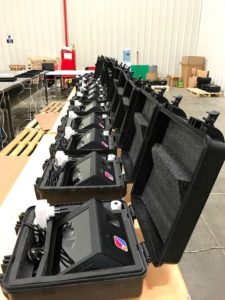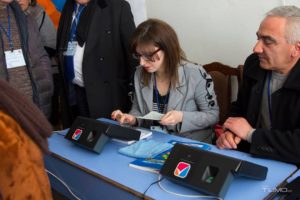On April 2, 2017 voters across Armenia went to the polls in the first election since a new Constitution was adopted in 2015 that changed Armenia’s political system from semi-presidential to parliamentarian. The newly elected National Assembly will gain increased executive powers when the incumbent President finishes his term in 2018. The April 2 vote was contested by nine parties and blocs and only four passed the threshold and formed the 101-member National Assembly.
The Central Electoral Commission (CEC) of Armenia announced 60,86% of voter turnout, corresponding to 1,577,322 out of approximately 2.5 million registered voters. More than 28,000 observers from around 50 domestic observation groups, as well as nearly 650 international observers including OSCE/ODIHR (Organization for Security and Cooperation in Europe – Organization for Democratic Institutions and Human Rights) and European Parliament representatives observed the vote in 1997 polling stations across the country.
With the generous support of the European Union and the Governments of the US, UK, Germany as well as Armenia, the UNDP Support to Election Process in Armenia (SEPA) project successfully procured 4,000 Voter Authentication Devices (VADs) which were deployed in 1997 polling stations across the country. The software for the VADs and the voter authentication procedures were developed with the support of SEPA Advisors.
The CEC conducted a three-level cascade training for trainers and VAD operators with the support of the SEPA Training Advisors. 4,962 VAD Operators passed the official test and 4,000 Operators were deployed by the CEC to polling stations each operating one device.

To increase voter awareness on technical and other procedural novelties introduced by the Electoral Code in 2016, SEPA’s Voter Education team, in cooperation with the CEC, produced as many as 200,000 booklets, 500 sets of posters, 2 TV and 3 Radio spots, in what was the largest voter education campaign conducted in Armenia since its independence. The UNDP Voter Education team, was also instrumental in addressing a request from the Ministry of Defense of Armenia to support voter education among the military personnel, which included many first-time voters.
On April 3, 2017, the ODIHR Election Observation Mission (EOM) issued a statement on preliminary findings and conclusions which was followed by statements from the US and UK Embassies and the EU Spokesperson, all agreeing that the elections were well administered and the technical novelties served the purpose.
The ODIHR EOM welcomed the introduction of VADs as a “useful tool for building confidence in the integrity of election day proceedings” and stated that on April 2 “the process of voter identification through the VADs was conducted efficiently and without significant issues”. Another large observation mission from the Commonwealth of Independent States noted that “those technical novelties made the process more transparent and maximally hard for falsification.”
The April 2 election will have far-reaching implications for Armenia’s future. In this context, the UNDP SEPA project provided a critical support to national stakeholders in effectively implementing new electoral technology in line with the government’s commitment to organize credible and inclusive elections.



